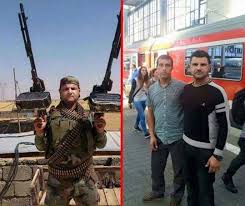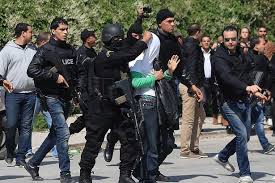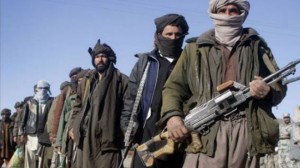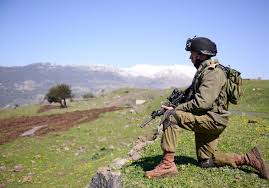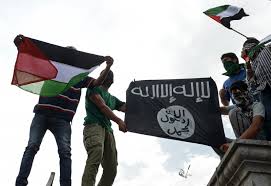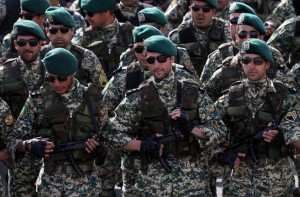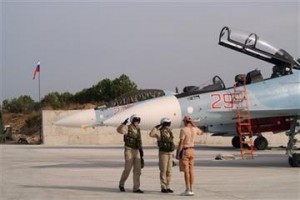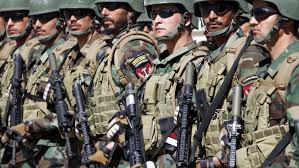ISIS terrorists exploiting migrant crisis by ‘recruiting refugees from asylum camps in Europe’
ISIS extremists have been spotted attempting to recruit refugees from asylum camps in Europe, police have said.
Supporters of the Islamic terrorist monsters were spotted chatting to Syrians at an asylum centre in Oslo, Norway.
Authorities have already registered concerns that, given their desperate situation, refugees may be vulnerable to radicalisation as they flee towards European cities.
A spokesman for the Norwegian Police Security Service said: “We have seen signs that extreme Islamists have approached the reception centres and asylum seekers.
“They have been there to get contacts.
“Aside from that, it’s difficult to say what their specific purpose is.
“We are of course worried about recruitment into radical circles.
“Of course we are worried about every single person that may be recruited by extreme Islamists and their cause.”
And Hugo Limkjær, the manager of the asylum centre in Oslo, confirmed that ISIS supporters had been spotted talking to the refugees.
He said: “We had an incident here with an Islamist who has been in Norway for some years.
“His message was that the West had helped to destroy his homeland and they had to stand together within Islam.
Tunisia: islamic terrorist networks specialising in illegal import of weapons dismantled
Several terrorist networks specialised in illegal import of weapons particularly from Libya, were recently dismantled, Secretary of State in charge of Security Affairs Rafik Chelly said, Saturday.
On a visit in the governorate of Bizerte, he added that the ministry has developed “well-studied” programmes that helped dismantle networks which finance families of Tunisians in hotbeds of tension.
The security situation in the country has clearly improved thanks to the continuous vigilance of the various security and military units, he stressed.
Afghanistan: Taliban planning to sneak into Turkmenistan from Jawzjan
The governor of Jawzjan’s Kham Ab District says that Taliban militants are planning to sneak into Turkmenistan.
Engineer Ahmad said that Taliban are trying to have a permanent presence in his district to implement their plans.
“Kham Ab shares a border with Turkmenistan. Therefore, the enemy is trying to keep the district instable in order to sneak into Turkmenistan and secretly began its activities there,” Ahmad told Radio Azadi.
Meanwhile, Media Advisor and Spokesperson to the First Vice President says that 80 Taliban have fled to an island in Amu River that separates Afghanistan and Turkmenistan.
Sultan Faizy said First Vice President Abdul Rashid Dostum who leads the military operation in Faryab and Jawzjan province has shared the issue with Turkmenistan’s Ambassador for Afghanistan.
According to Faizy, Turkmenistan has preparedness to cope with any possible militant threat, adding that militants have two options.
“If decide to surrender, it is one option. And another option is they likely die. Because, it is winter and they don’t have access to logistical resources or food,” Sultan quoted by Azadi Radio as saying.
However, Taliban in a statement on their website say that their fighters have no need to spill over to Turkmenistan.
khaama.com
IDF: Arab-Israeli paraglides into Syria from Golan Heights
An Arab-Israeli was spotted paragliding across the Golan Heights border into Syria by an Israeli Defense Force watchtower Saturday afternoon, according to a statement posted on an official IDF Twitter account.
The IDF statement says that its initial investigation suggests the person crossed intentionally.
A Jerusalem Post article quoted a IDF spokesman as saying that the paraglider, a 23-year-old resident of the town of Jaljulia, crossed the border in order to join a militant group in Syria.
“We believe he planned this move to the other side, and joined a group there,” Brig.-Gen. Moti Almoz told reporters during a conference call, the Post reported.
Another IDF statement said that Israeli forces are still trying to ascertain the individual’s intentions.
The Golan is regarded internationally as occupied territory despite Israeli annexation. It is home to 41,000 residents, including Jews, Druze and Alawites.
Israel captured the territory from Syria during the 1967 Israel-Arab war, and it was eventually annexed.
ISIS trying to co-opt Palestinian Jihad against Israel as part of its own cause
The Islamic State (ISIS/ISIL), through several of its media organs, has expressed support for the deluge of Palestinian terrorist attacks currently plaguing Israel, calling for more.
A new report by the Washington, D.C.-based Middle East Media Research Institute (MEMRI) Jihad and Terrorism Threat Monitor argues the new outbursts of support for Palestinian terrorism is an attempt to commandeer the cause as part of its own.
ISIS considers itself the authority in political and religious matters for all Muslims, with its Caliphate backing Sunnis who fight its enemies.
ISIS regards the Muslim Brotherhood’s movements and affiliates, such as the terrorist group Hamas, as too pragmatic and not radical enough. “In much of the Islamic world, when there are various approaches, the radical one tends to trump those deemed to be weaker,” notes The Jerusalem Post.
According to a poll conducted by the Arab Center for Research and Policy Studies in Doha, Qatar, late last year, nearly one-quarter of Palestinians had positive views of ISIS. However, “the pro-ISIS presence within the Palestinian territories should not be exaggerated. It is primarily limited to small and divided pro-IS groups in Gaza,” Middle East Forum fellow Aymenn Jawad al-Tamimi told The Jerusalem Post.
That being said, ISIS “does not need to have an operational presence on the ground in Israel to be effective, as its propaganda over the Internet can serve as an incitement tool for more attacks,” declares the Post.
ISIS has embarked upon a media campaign that involves the release of a series of videos in support of the ongoing terrorist attacks in Israel and encouraging the Palestinians to carry out more lone wolf assaults, the new report by MEMRI reveals.
As he congratulates the Palestinian attackers on their recent attacks on the Jews, the narrator of a nine-minute video declares:
Oh mujahideen, we call on you to prepare yourselves spiritually and materially to strike terror and fear into the hearts of the Jews. … Know that the soldiers of Islam are fighting here in Iraq, Syria, Khorasan, and West Africa, but their sights are set on Bayt Al-Maqdis [Jerusalem].
The footage was released by ISIS’ information office in Mosul, Iraq’s second largest city. Mosul fell to ISIS in June 2014. Khorasan is an ancient name for a region that covers large parts of Afghanistan, Pakistan, Iran, India, and other surrounding countries.
The MEMRI report noted that “a substantial part of these videos is dedicated to ideological attacks on Hamas and Fatah.”
“Fatah has become an agent of the infidel Jews and Christians, while Hamas is doing the bidding of the Shi’ites [Iranians] and Alawites [the regime of Syrian dictator Bashar al-Assad],” said the report.
The Middle East Forum’s Tamimi told the The Jerusalem Post that ISIS rhetoric in support of the deteriorating security situation on the ground in Israel fueled by the Palestinian attacks is an effective means to make headlines.
It also “fits in with [the] idea of supporting the cause of Muslims everywhere,” said Tamimi who closely monitors Islamist opposition groups in Iraq and Syria.
ISIS has established a foothold in Iraq, Syria, Libya, Egypt, and other regions and is expanding its presence across the globe, with its affiliates pushing for power as far as its Khorasan Province–Afghanistan.
“Arab youth in the Palestinian territories and Israel are influenced by the storm waging in neighboring countries and are willing to join the call to action and seek martyrdom for the sake of their cause,” notes the Post.
“But for now, Islamic State is more of an observer to the violence waging in Israel as local groups such as Hamas have the advantage in claiming the terror as its own because of proximity and its experience waging war against Israel, not only in words,” it adds.
breitbart.com
More Iranian troops sent to support Assad in Syria
A senior Iranian official said late Friday that his country has sent more troops to fight alongside the regime of Bashar al-Assad in Syria, according to Iran’s semi-official Fars News Agency.
The agency quoted General Ramazan Sharif, spokesman of the Revolutionary Guards, as saying that “Iran increased the number of its soldiers in the region” as part of a new ground offensive in Syria.
Iran has been supporting the embattled Assad regime and has lost eight senior military officers inside Syria in recent weeks.
At least 250,000 people have been killed since the Syria conflict began in 2011, with 7.6 million internally displaced and over four million having fled to other countries.
Amid Anti-ISIS Airstrikes, will Russia and US team to fight Islamic State in Syria?
After carrying out airstrikes on so-called terrorist targets in Syria daily during the past month, Russia now wants to work with the U.S. in fighting terrorism in the war-torn Middle Eastern country, Foreign Minister Sergei Lavrov said on national television Saturday. The statement came after the Russian foreign minister and U.S. Secretary of State John Kerry conducted talks in Vienna Friday centered on launching a political process that would bring together for peace talks the authoritarian regime of Syrian President Bashar Assad and opposition forces.
“We are ready for such a profound coordination,” Lavrov said during an interview on the news program “Vesti v Subbotu,” according to Russia’s official news site Sputnik International. “We are ready to include the patriotic opposition, including the so-called Free Syrian Army, to provide it with aerial support, although we were declined information on where, according to U.S. data, terrorists are located, and where is the patriotic opposition.”
While Russia has been conducting bombing raids in Syria since the end of September, it has been militarily involved in the country since it began moving both humanitarian aid and weapons there almost seven weeks ago. In addition to aiming at Islamic State group targets, Russia’s military has targeted Syrian rebel forces that oppose Assad’s government.
However, the Vienna talks bringing together representatives of Russia and the U.S., as well as Saudi Arabia and Turkey, appear to have made some progress in developing an understanding between the former Cold War rivals with respect to the Syrian Civil War. The most important jobs for Moscow now is to begin dialogue with opposition groups in Syria and continue talks with the U.S., Lavrov said during the TV interview.
“When a person refuses to talk on serious issues, a question arises, whether this person understands what is going on, whether a person has ideas on how to settle a problem,” Lavrov said on the show carried by the TV channel Rossiya-1. “When our U.S. colleagues come out with such initiatives, we always react and never avoid a conversation.”
Kerry, who has remained in close contact with Lavrov throughout the fighting in Syria, alluded to the fact that there must be change there after his meeting with Lavrov. However, the secretary of state was realistic about the differences of opinion in Moscow and Washington over how to bring peace and resolve the war.
“The hard work of shaping that transition [in Syria] requires an international approach and a consistent approach,” Kerry said following the meeting in the Austrian capital, according to the Wall Street Journal. “There remain differences among us about exactly what the final approach looks like.”
ibtimes.com
New Russian military might on full display in Syria
Sleek combat jets loaded with precision bunker-buster bombs roar into the skies as soldiers in desert-style uniforms march past rows of neat housing at this Russian military base at one of Syria’s largest airports.
The air campaign in Syria, Russia’s first military action outside the former Soviet Union since the war in Afghanistan, shows a revamped Russian military, which sharply differs in both capability and mindset from the old, Soviet-style force.
It is capable of quickly projecting power far from Russian borders, widely uses drones and precision weapons, and cares about soldiers’ comfort.
The thunder of Syria’s civil war couldn’t be heard at Hemeimeem, located in the coastal province of Latakia, which has largely been spared the chaos and destruction of more than 4 1/2 years of fighting in Syria.
A small group of journalists visiting the base this week could see a dozen Su-24 bombers taking off into the night with a deafening roar, piercing the darkness with scarlet flames from their engines.
Such missions were impossible just a few years ago, when the Russian air force had few planes capable of hitting targets at night.
As part of President Vladimir Putin’s sweeping military modernization program, the air force received hundreds of new and modernized aircraft, all equipped with state-of-the art electronics on a par with U.S. and NATO jets.
“All aircraft here at the base are equipped with targeting systems that allow hitting targets with pinpoint precision,” said Defense Ministry spokesman Maj.-Gen. Igor Konashenkov.
He dismissed Syrian opposition claims that the Russian airstrikes killed civilians as “sheer nonsense,” saying the aircraft have hit ammunition depots, bunkers and other targets away from populated areas. The ministry has released cockpit video to support its claims, just as the Pentagon did during the two Gulf wars.
The precision strikes differ sharply from Russian operations to quash two separatist insurrections in Chechnya, where the Russian military indiscriminately used obsolete, inaccurate weapons, reducing the Chechen capital of Grozny to rubble.
Latakia, the heartland of Syrian President Bashar Assad’s Alawite minority, offers the Russian military a safe environment – and a warm welcome from people blaring car horns and chanting “Thanks!” in Russian.
At a refugee camp in Latakia, which houses several thousand mostly Alawite refugees from other provinces in Syria, smiling kids shouted: “Thank you, Putin!”
Warmly greeted by the locals and at a safe distance from the front lines, Russian soldiers at the base look calm and relaxed.
Still, Russian military police manning checkpoints with Syrian security forces thoroughly check incoming vehicles, special forces guard key facilities and Mi-24 helicopter gunships sweep around the base on regular patrols looking for any suspicious activity. Pantsyr air defense systems are deployed at the edge of the airfield, completing the security bubble.
Soldiers at the base are visibly proud of their crisp new uniforms and comfortable sand-colored high boots, a stark contrast with the drab Soviet-style military attire worn until recently.
Air force support crew attaching heavy bombs and missiles under the warplanes’ wings wear shorts and white sports shoes for comfort in very un-Russian temperatures of nearly 30 Celsius (mid-80s Fahrenheit).
On a typical day, each jet flies several sorties during the day and at night.
Konashenkov shrugged off U.S. criticism that Russia was targeting moderate rebel groups fighting Assad instead of focusing on Islamic State militants, the main goal declared by the Kremlin. He argued it doesn’t matter which of the myriad militant groups owns facilities making suicide belts and rigging trucks with explosives for suicide missions, which the Russian warplanes target.
In another break with the old Russian military tradition, the planners of the Hemeimeem base took care of the troops, a marked departure from Soviet-style neglect of soldiers’ comfort.
The neat rows of housing units, each holding from two to eight men depending on rank, are equipped with air conditioning, a must in the scorching heat, and there are plenty of wash cabins available.
A field kitchen and a canteen look immaculately clean, a sight to shock anyone familiar with crude ways of the old-style Russian military.
At the base’s water treatment unit, Lt.-Col. Alexander Yevdokimov spoke enthusiastically about a multilayer filter system that purifies Syrian tap water to the highest drinking standard and prevents any threat of chemical or bacteriological contamination.
“Please try it, it tastes really good!” he told reporters.
The base bakes its own bread and cooks prepare no-frills but filling Russian dishes. An army store offers souvenirs, cosmetics and clothing, and smiling attendants at a nearby coffee shop sell candies, cookies and ice cream delivered from Russia.
Konashenkov, a veteran of the war in Chechnya and other post-Soviet conflicts, is keen to highlight the progress the military has made.
“Remember Chechnya, where everything was covered in dirt?” he asks, pointing at the base’s freshly paved grounds that help keep uniforms and housing units clean.
Officers at the base say its comfortable layout and logistics reflect the personal touch of Russian Defense Minister Sergei Shoigu, who is widely popular in the ranks, unlike his predecessor, Anatoly Serdyukov.
Serdyukov, who was ordered by Putin to streamline the bloated and under-funded military after the 2008 Russia-Georgia war, conducted painful cuts of the officer corps and made other radical changes, but was eventually sacked amid growling in the ranks.
The military welcomed the appointment of Shoigu, who had served as Russia’s emergencies minister for two decades and won a reputation as one of the few Russian officials who could actually get things done.
A latecomer to Putin’s inner circle, Shoigu has developed strong personal ties with the president. They have gone fishing together and the defense minister now seems to be one of the few officials whom Putin particularly trusts.
Spending on the military increased under Shoigu’s leadership, financing hundreds of new aircraft and missiles and the commissioning of numerous other new weapons.
The armed forces have held a series of massive exercises, engaging hundreds of thousands of troops and hundreds of aircraft across vast areas from the Baltics to the Pacific and from the Caspian Sea to the Arctic.
The drills paid off when Putin moved to annex Crimea from Ukraine in March 2014. Within hours, waves of Russian transport planes airlifted special forces that quickly blocked Ukrainian troops at their bases without firing a shot. The swift operation took the West by surprise.
Unlike the past, when the military’s post-Soviet meltdown forced the Kremlin to rely increasingly on nuclear weapons, it has grown more confident about its conventional forces.
The rapid deployment of a sizable expeditionary force by sea and air, an air campaign in which dozens of jets relentlessly pounded targets round the clock for weeks and the launching of long-range cruise missiles from the Caspian were intended to send a clear message: Russia’s military could rival U.S. operational capability.
Putin has pointed at the launch of 26 cruise missiles from Russian navy ships in the Caspian at targets in Syria 1,500 kilometers (930 miles) away as a signal to the U.S. that Russia can pack a similar punch.
Konashenkov, the Russian Defense Ministry spokesman, shrugged off the Pentagon’s claim that four of the missiles crashed in Iran.
“All those targets (in Syria) must have exploded all by themselves then!” he said with a sardonic smile, insisting that every Russian missile hit its target.
ap.org
Afghan special forces in firing line as fighting spreads
As Afghan soldiers and police struggle to contain an escalating insurgency that has targeted several cities in recent weeks, the country’s special forces are being tested as never before.
Trained in counter-insurgency tactics at the elite School of Excellence near Kabul, these soldiers led the battle to retake Kunduz, after regular forces fled their posts last month to cede the northern city to militants they easily outnumbered.
“The credit for the Kunduz victory goes to the Afghan special forces of the police and Afghan National Army,” said interior ministry spokesman Sediq Sediqqi, referring to the government’s recapture of most of Kunduz a few days after it fell to the Taliban in late September.
“They are tough fighters.”
Events surrounding the first capitulation of a provincial capital to the Taliban since they were ousted from power in 2001 underlined the weakness of Afghanistan’s regular army and police and the relative strength of its special forces.
Worryingly for Kabul and the United States, which has spent around $65 billion training local forces to allow the rest of its troops to withdraw, Afghan special forces are feeling the strain.
Numbering about 18,000 of a total Afghan National Security Force of up to 350,000 and divided between the army, police and Interior Ministry, Afghan special forces units and commandos undertook 2,800 independent operations in the year to May 2015, according to a report from the U.S. Department of Defense.
“Our forces shoulder a lot of responsibility and sometimes they have to respond to attacks as often as twice a day,” said Abdullah Guard, head of police special forces in Kunduz.
“WE WILL LOSE EVERYTHING”
With better equipment, training and pay, as well as more prestige than regular troops, special forces are the first units turned to in a crisis.
That burden was bothering Afghan special forces commanders even before the dramatic events in Kunduz.
Since then, heavy fighting has flared near Ghazni, a city 130 km southwest of Kabul, and, in the last few days, around Lashkar Gah in the south, Herat in the west and in the northern Faryab province bordering Turkmenistan.
Some commanders are concerned that too much reliance is being placed on units originally intended to provide specialized back-up to regular security forces.
“Commandos are not being used in the way they were supposed to be,” one Afghan commander complained to a team of U.S. special forces at a remote outpost in Paktia province, close to the Pakistan border where the Taliban have long been active.
“They’re being used like a conventional unit,” he added at a meeting this summer convened for the benefit of a visiting U.S. special forces commander. The Afghan officer declined to be named, because he was not authorized to speak to the press.
“If they continue to use commandos like a conventional force, we won’t get any new recruits and we will lose everything that we have.”
As training has been handed from U.S. to Afghan instructors, there have been complaints from some officers that the quality of recruits has fallen.
“When we get them, we have to teach them everything from the beginning,” the Afghan commander said.
As international forces step back from active combat, the dynamic between U.S. and Afghan special forces units has shifted, with American soldiers leaving most of the fighting to local colleagues.
“We’re not going out as much as we used to, and that’s a good thing,” said one U.S. special forces adviser.
The Americans’ main role, according to command sergeant major James Napolet, NATO Special Operations Command Component-Afghanistan, is to support Afghans where their resources are weakest, including intelligence and medical evacuation.
GROWING CAPABILITY
NATO’s 13,000-strong Resolute Support force is there to “advise and assist” after the main combat mission, numbering 130,000 soldiers at its peak, ended last year.
A few thousand more U.S. troops engage in hunting senior Taliban and al Qaeda figures.
In the heat of battle, lines between Afghan and foreign special forces can become blurred.
On Oct. 1, U.S. advisers working alongside Afghan special forces came under attack from Taliban fighters in Kunduz and returned fire, which a NATO spokesman said was within their remit to “protect themselves if necessary”.
The U.S. military has taken responsibility for the bombing of a hospital in Kunduz that killed 22 staff and patients, which it said came in response to an Afghan request for air support.
But U.S. and Afghan special forces also point to notable successes.
Earlier this month, General John Campbell, commander of U.S. forces in Afghanistan, hailed one of the biggest ground assaults his forces had conducted, targeting al Qaeda cells in Kandahar province in the south.
While a statement did not specify the involvement of special forces, the operation was the kind carried out by elite commandos.
“I couldn’t be prouder of our brave U.S. servicemen and women and their Afghan counterparts,” Campbell said. “It’s because of their extraordinary efforts that terrorists here haven’t been able to attack our homeland in over 14 years.”
thepeninsulaqatar.com

